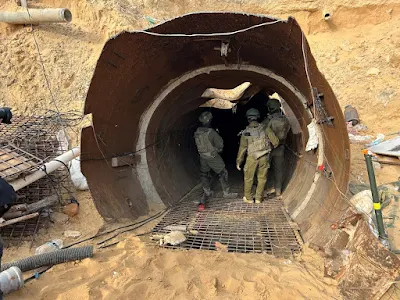Gaza, June 27 — Under intense Israeli military pressure and facing internal dissent, Hamas is grappling with a severe erosion of its power base in Gaza. According to multiple sources close to the group, the Islamist faction is battling to retain operational capacity while contending with rebellious tribal elements and growing uncertainty over continued Iranian support.
Following the destruction of vast segments of its tunnel infrastructure and the loss of senior commanders, Hamas fighters are now operating in isolated cells, instructed to hold their ground for as long as possible. However, sources say the group’s ability to exert centralized control is rapidly diminishing, as local clans—some reportedly backed by Israel—challenge its authority.
The deepening humanitarian crisis in Gaza, coupled with increasing international calls for a ceasefire, has further complicated Hamas’ position. “A temporary truce would not only ease pressure on civilians but also give Hamas a chance to regain internal control and suppress rogue factions,” said one individual familiar with internal deliberations.
Israel Targets Hamas’ Command Structure
Israeli officials estimate that over 20,000 Hamas militants have been killed since the conflict reignited in 2023, with hundreds of miles of tunnel systems either destroyed or rendered inoperative. “The average age of Hamas fighters is decreasing by the day,” an Israeli security source noted, attributing the trend to recruitment among displaced, unemployed youth in Gaza.
Despite its losses, Hamas continues to carry out limited operations. A deadly ambush in southern Gaza earlier this week killed seven Israeli soldiers. Still, Middle East-based diplomats and intelligence assessments suggest Hamas has largely lost centralized command and is now limited to conducting sporadic, low-scale attacks.
“They are no longer the organized force they once were,” said Essam, a Gaza-based construction worker. “But they’re still here—guarding aid convoys, keeping order where they can.”
Internal Dissent and the Rise of Abu Shabab
A major challenge has emerged in the form of tribal opposition, notably from Yasser Abu Shabab, a Bedouin figure accused by Hamas of collaborating with Israel. According to Hamas sources, top fighters were dispatched to neutralize him, but he remains elusive in the Rafah area, currently under Israeli control.
Abu Shabab’s faction has taken control of key areas in eastern Rafah and is reportedly facilitating humanitarian aid, including managing the flow of supplies through the Kerem Shalom crossing. While the group denies seeking political control or receiving Israeli support, it has made public overtures to displaced residents, offering food and shelter.
A Hamas security official vowed decisive action against Abu Shabab’s group, describing them as “agents of chaos” and promising to “strike with an iron fist.”
Not all clans oppose Hamas. In northern Gaza, a tribal alliance has reportedly cooperated with Hamas to protect aid convoys. However, conflicting narratives persist—Israel alleges Hamas seized the trucks, while both the clans and Hamas deny the charge.
Iran’s Role Under Scrutiny
Further complicating Hamas’ strategic calculus is the shifting geopolitical landscape following Israel’s recent strikes inside Iran. Among the casualties was Saeed Izadi, a key Islamic Revolutionary Guard Corps (IRGC) officer believed to have overseen coordination with Hamas and other proxy groups. His death raises questions about the sustainability of Iran’s logistical and technical support.
While both Tehran and Hamas have maintained a show of unity—Hamas called Izadi a “friend of the resistance”—Palestinian sources acknowledge that Iranian assistance could wane. “There may be a recalibration in both the funding and military training that Iran provides,” one official close to the group said.
Despite these concerns, Hamas maintains a firm stance on negotiations. Senior official Sami Abu Zuhri reiterated that the group is open to a ceasefire agreement but ruled out surrender. “We are committed to an agreement that ends the war, facilitates a full prisoner exchange, and sees the withdrawal of Israeli forces. Surrender is not on the table.”
A Diminished But Enduring Force
Since its formation in 1987 and takeover of Gaza in 2007, Hamas has been the dominant power in the enclave. But the toll of the war has been unprecedented. According to Gaza health authorities, over 56,000 people have been killed, while Israeli figures cite 1,200 deaths and 253 hostages taken during the October 2023 assault.
Yezid Sayigh of the Carnegie Middle East Center believes Hamas’ current battle is not just military but existential. “It’s a fight for political survival,” he said. “If the war continues, Hamas risks not only military extinction but also being excluded from any future governance framework in Gaza.”
As regional focus shifts from Iran-Israel tensions to Gaza’s future, international actors—most notably the United States—are working to broker a lasting ceasefire. President Donald Trump recently remarked that “great progress” was being made on Gaza, linking it to the broader pressure campaign on Iran.
Still, the road to any resolution remains fraught. “We keep the faith,” said a Hamas source. “But in reality, it doesn’t look good.”
With its military structure fractured, tribal rivalries deepening, and strategic alliances under strain, Hamas now finds itself in one of the most precarious positions since its inception—struggling not only to win a war but to remain relevant in the future political order of Gaza.




.png)
The opinions posted here do not belong to 🔰www.indiansdaily.com. The author is solely responsible for the opinions.
As per the IT policy of the Central Government, insults against an individual, community, religion or country, defamatory and inflammatory remarks, obscene and vulgar language are punishable offenses. Legal action will be taken for such expressions of opinion.